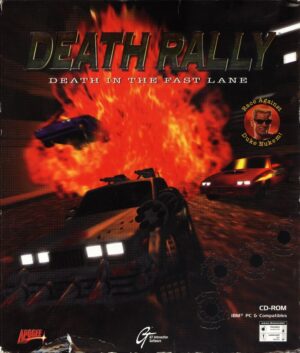Retro Replay Review
Gameplay
Hearts of Iron II: Doomsday – Armageddon builds on the solid grand strategy foundation of its predecessor by adding two fresh campaigns, Abyss and Armageddon, each beginning in 1936 with unique starting conditions. In Abyss, you command a modest force while the world remains at peace, offering a tense, slow-burn buildup as you navigate alliances and industrial growth. Armageddon thrusts you directly into total war, with powerful armies already clashing and every decision carrying immediate weight on the battlefields of Europe, Asia, and beyond.
(HEY YOU!! We hope you enjoy! We try not to run ads. So basically, this is a very expensive hobby running this site. Please consider joining us for updates, forums, and more. Network w/ us to make some cash or friends while retro gaming, and you can win some free retro games for posting. Okay, carry on 👍)
The strategic depth is further enriched by geography-driven imbalances: some countries boast extensive coastlines ripe for naval invasions, while others wield sprawling land borders that demand constant vigilance. This naturally uneven landscape forces players to adapt their playstyle—whether that’s fortifying narrow mountain passes, constructing massive fleets, or launching rapid armored offensives across the plains. As a result, no two playthroughs feel identical, even if you select the same faction twice.
Armageddon introduces practical enhancements to naval warfare, such as radar installations, upgraded air-raid defenses, and incremental tech upgrades for individual ships. These additions may seem small at first glance, but they dramatically impact mid- and late-game naval engagements. Deciding which vessels to retrofit or prioritize gives admirals real strategic choice, transforming once-static fleets into dynamic forces capable of turning the tide at sea.
Another welcome improvement is the flexibility in annexation policies. When conquering new territories, you can now opt to retain the existing tech teams and full industrial output of a region, reflecting more nuanced occupation strategies. This feature incentivizes diplomatic subterfuge, espionage, and selective expansion, ensuring that each conquest feels meaningful and that the spoils of war truly bolster your military machine.
Graphics
While Hearts of Iron II’s engine wasn’t designed as a showcase of cinematic visuals, Armageddon refines the map textures and unit sprites to deliver a cleaner, clearer strategic overview. Provincial borders are more distinctive, resource icons have been polished, and weather effects are subtly enhanced, improving readability during intense sessions where every detail matters.
The updated naval icons for radar-equipped vessels and air-defense platforms are particularly noteworthy, easily distinguishable at a glance and satisfying to see change as you research new technologies. Although these graphical tweaks don’t reinvent the wheel, they demonstrate the developer’s dedication to quality-of-life improvements in a genre where information density is paramount.
User interface windows have also been tweaked to accommodate the new annexation options and campaign selection screen. Tooltips provide concise explanations of Abyss versus Armageddon start conditions, and the research tree now highlights naval increments, making your path to technological supremacy more intuitive than ever.
Story
At its core, the narrative of Armageddon is a “what-if” scenario dressed in alternate history, featuring eight fictional superstates like the European Soviets (formerly England) and the House Bourbone (formerly France). These bold redesigns of familiar nations give players a fresh canvas for rewriting history, from forging unlikely alliances to staging coups that topple entire continents.
The campaigns subtly weave tension into every diplomatic exchange, from fragile non-aggression pacts to sudden declarations of war. In Abyss, early-game diplomacy is crucial as you attempt to build support without triggering hostilities; in Armageddon, you must navigate betrayals and flanking maneuvers in a world already ablaze. This duality ensures a strong narrative drive whether you prefer patient preparation or ruthless aggression.
Emergent storytelling is the strength of any grand strategy title, and Armageddon excels here. There are no scripted set-pieces—every front you open and every front you hold contributes to a sprawling, player-driven saga. The satisfaction of executing a daring airborne assault or foiling an enemy naval blockade elevates the immersion far beyond what a linear storyline could achieve.
Overall Experience
Hearts of Iron II: Doomsday – Armageddon is an essential expansion for veteran grand strategists and a compelling entry point for newcomers curious about deep, alternate-history warfare. The booster pack’s dual campaigns effectively double the replay value, offering both a measured, build-up experience and an all-out war scenario that tests your mettle from the first turn.
The added naval upgrades and annexation choices showcase the developers’ attention to detail, giving you more tactical options without overcomplicating the core mechanics. If you’ve ever wished for more control over conquered provinces or finer naval customization, Armageddon delivers these features with finesse.
Of course, the steep learning curve and complex micromanagement may intimidate casual players. But for those who relish plotting multi-theater offensives, managing sprawling economies, and outmaneuvering rival superpowers, this expansion is a treasure trove of strategic possibilities. Few grand strategy games offer such breadth and depth in a single package.
Whether you’re rallying the European Soviets for global domination or leading the House Bourbone into pitched land battles, Hearts of Iron II: Doomsday – Armageddon offers an engrossing, highly replayable experience. Its well-balanced campaigns, meaningful enhancements, and sprawling alternate history setting make it a must-have for any devotee of the genre.
 Retro Replay Retro Replay gaming reviews, news, emulation, geek stuff and more!
Retro Replay Retro Replay gaming reviews, news, emulation, geek stuff and more!




Reviews
There are no reviews yet.